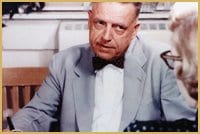Does queerculture owe a big debt to a white bow tie-wearing married Republican male? You bet it does.
Yes, that’s correct. Kinsey, the terrific documentary by Barak Goodman and John Maggio, makes it obvious that the research and publications of this entomologist turned sex researcher from the conservative American Midwest had unparalleled implications for anyone concerned about sexual freedom and equality.
His dedication to science and his intolerance for prudery led to influential and popular publications-on men in 1948 and women in 1953-that opened minds to the diverse sexual possibilities visible today.
Interestingly, Kinsey’s groundbreaking work was in many ways a fortunate accident. While studying his huge collection of gall wasps, Kinsey the entomologist developed a theory about species diversity in nature.
Later, an outbreak of venereal disease at his university resulted in his teaching a new class in 1938 on marital relations that revealed how incredibly uneducated students were about all matters sexual.
That hugely popular class was so frank and revealing that it apparently caused blushing students to nearly pass out.
Like the equally worthwhile feature film of last year, this 2003 documentary traces Kinsey’s personal and professional history. He had an overbearing and religious father, an increasingly open marriage, sexual experiences with men and quarrels with conservative colleagues who disagreed with his motto, “inquiry over dogma”.
Kinsey founded the Institute for Sex Research and, over a period of 15 years, interviewed more than 10,000 people, including his students and family, about the details of their sex lives.
The directors also spend many welcome minutes explaining American sexual attitudes during Kinsey’s time, which may seem shockingly Victorian to generations now familiar with the explicitness of mainstream sexual discourse like Dan Savage, Josie Vogels or Queer as Folk.
Kinsey himself was raised to accept many phobic attitudes about sex. As a Boy Scout he prayed to have his terrible masturbatory urges disappear, and as a professor he routinely encountered dizzying beliefs and attitudes.
For instance, when Sexual Behavior in the Human Female came out in 1953, selling more than 200,000 copies, one of the biggest shocks was that Kinsey’s empirical data proved that healthy and ordinary women do actually have sexual impulses.
His work helped dispel a great number of myths and fears and introduce ideas about sexual fluidity and variety.
Not strictly a hagiography, the documentary does discuss the weaknesses of his research and his various methodological glitches.
A stellar example of research-fuelled storytelling, Kinsey captures the man and his times with impressive style.
Kinsey’s last research findings coincided with the Cold War’s return to family values and fear of unknowns.
He died in 1956 saddened at the return of cultural blinders. Viewers living five decades after his last book can only be thankful for his courage to loudly protest the restrictive truths of his day.

 Why you can trust Xtra
Why you can trust Xtra


